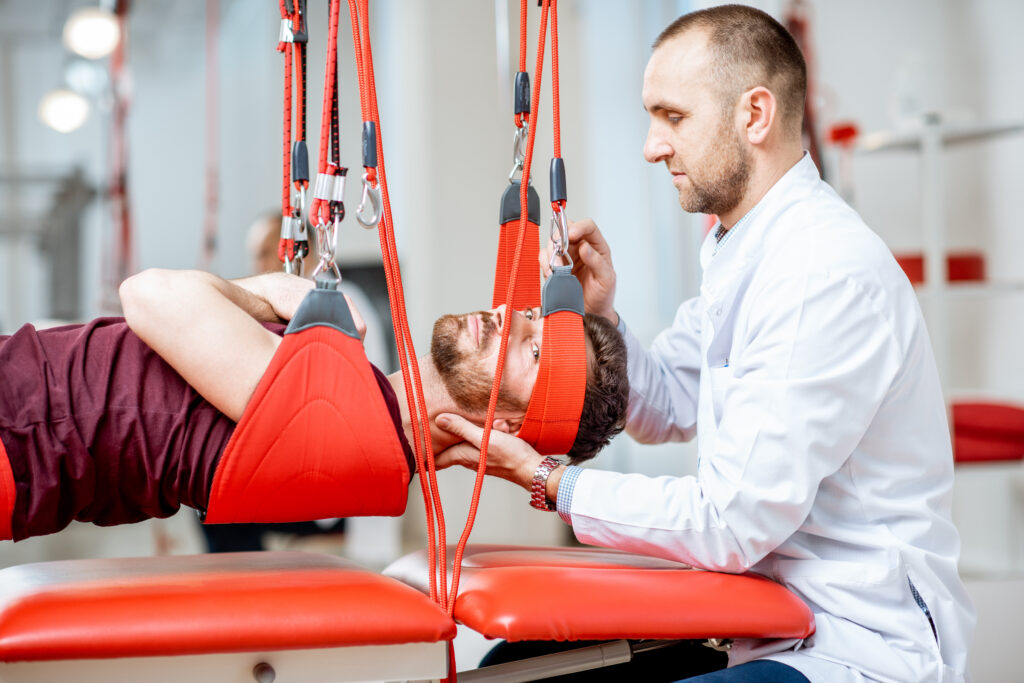Physiotherapy Treatment

Introduction
Physiotherapy is a vital service that focuses on rehabilitation and recovery for patients with spinal conditions. Its primary aim is to restore movement, reduce pain, and improve overall functionality. This is done through personalized exercise programs and manual therapy techniques.
Physiotherapists work closely with patients and develop personalized treatment plans that may include flexibility training, strengthening exercises, and postural correction strategies. These plans help patients manage their pain and prevent future injuries. Physiotherapy is collaborative in nature. It fosters a supportive environment, encouraging patients to participate in their recovery process. Many patients report great improvements in mobility and quality of life through regular sessions.

Types:
1. Sports Physiotherapy
The main goals of sports physiotherapy are to treat and prevent injuries sustained during physical activity. Sports physiotherapists employ manual therapy, specific exercises, and other approaches to increase mobility, hasten recovery, and boost athletic performance.
2. Geriatric Physiotherapy
Geriatric physiotherapy addresses the needs of elderlies who face challenges like reduced muscle strength, and slower reflexes. It focuses on managing conditions such as arthritis, osteoporosis, and general mobility issues.
3. Orthopaedic Physiotherapy
Orthopaedic physiotherapy treats musculoskeletal issues, including chronic back, neck, and knee pain, as well as post-surgical care. This therapy is ideal for patients recovering from fractures, ligament tears, or joint replacements.
4. Paediatric Physiotherapy
Pediatric physiotherapy focuses on children, from infants to adolescents, who may have developmental, neurological, or musculoskeletal issues. Techniques include play-based exercises, balance training, and postural correction to promote better coordination and mobility.
5. Neurological Physiotherapy
Patients with neurological conditions or traumas involving the brain, spinal cord, or peripheral nerves are treated here. Neurological physiotherapists employ methods such as muscle stimulation, gait training, and balance exercises to increase independence, improve motor function, and stop more problems.
Advantages
Physiotherapy offers a variety of benefits, making it a key part of rehabilitation and wellness.
- It helps heal pain, improve mobility, and quickens recovery from injuries or surgeries.
- It is personalized to individual needs, ensuring targeted treatments for conditions like musculoskeletal injuries, neurological disorders, and chronic pain.
- It also reduces dependence on medications by providing natural pain relief through exercises and manual therapy.
- Physiotherapy promotes long-term health by improving strength, flexibility, and balance, thereby preventing future injuries and enhancing the overall quality of life.
Risks and Possible Complications
Despite being mostly safe, there are some possible dangers and consequences associated with physical therapy.
- After sessions, patients may feel a brief sense of discomfort, soreness, or exhaustion, especially if they are exposed to new exercises or rigorous physical treatment techniques.
- In rare instances, using incorrect methods or exerting too much energy might exacerbate pre-existing injuries or cause new ones.
- If the therapy is not appropriately customized for their needs, people with certain medical disorders, such as severe osteoporosis or cardiovascular problems, may be in further danger.
- Working with a skilled physiotherapist who can adapt workouts and treatment plans to the patient’s condition and tolerance is crucial.
Recovery Period
Physiotherapy recovery times vary greatly based on the ailment being treated, the patient’s general health, and how well they follow exercise instructions. After two to six weeks of regular physiotherapy treatments, patients may experience noticeable improvement for acute ailments like sprains or strains. It may take several months of therapy to fully recover from post-surgical rehabilitation, such as following spinal or joint replacements.
